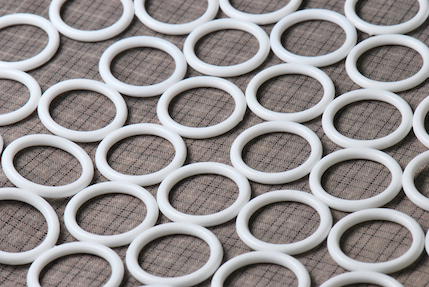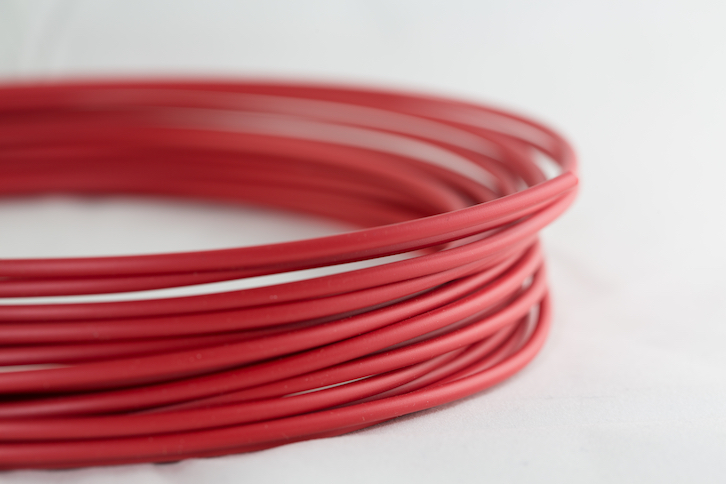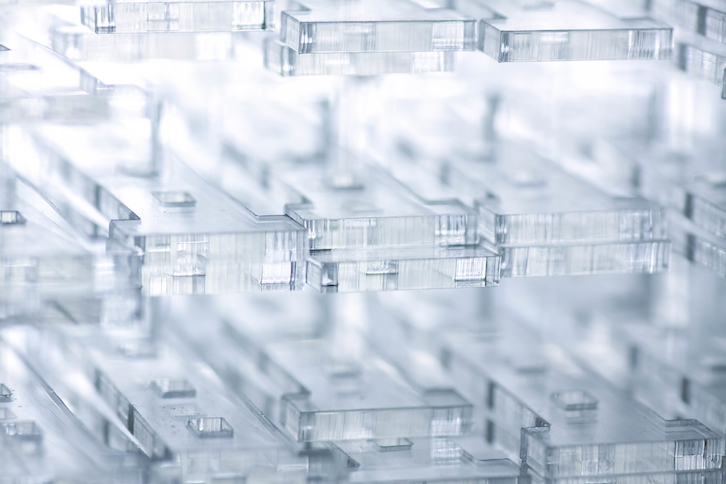
by
wecreate
|
March 9, 2023
|
Acrylic, PETG, Polycarbonate
Erie Industrial Plastics consistently stocks acrylic, polycarbonate, and PETG in a variety of thicknesses and colors. Our experienced staff can help you select which material is best for your application and offer insight on edge finishing, mechanical or adhesive fastening systems, hardware, and even cleaning products.
Benefits of Acrylic
Acrylic sheet is offered in wide variety of colors, surface finishes, thicknesses, and sheet sizes. It also can be purchased in rod and tube form for special projects. The surface of acrylic is relatively hard and resists scratching under moderate conditions. It can be bent, laser-cut, engraved, polished, and glued with great ease and optimum aesthetic value.
Acrylic is commonly used in sheet form for signage and glazing applications but because of its outstanding fabrication characteristics is also a favorite for display cases, literature racks, machine covers, candy bins, POP displays, and more.
Benefits of Polycarbonate
Polycarbonate is the most impact-resistant thermoplastic used in the glazing and signage markets. It comes in variety of sheet sizes and thicknesses to meet a wide range of industry demands. There are a few colors and finishes available to choose from, but the selection is more limited compared to acrylic. Polycarbonate can be machined, bent, glued, and mechanically fastened to produce machine guards and other enclosures; however, due to its composition, polycarbonate is not an ideal material to thermoform or polish.
Erie Industrial Plastics produces hundreds of polycarbonate machine guards every year for all types of businesses. Let us help you put safety first with free design advice on your next guarding application.
Benefits of PETG
Like acrylic, PETG is a clear thermoplastic sheet that is commonly used for fabricated products. It is easily cut, machined, and glued for assembly and also can be thermoformed to produce very detailed and uniquely designed parts. It is softer than acrylic, making it more vulnerable to scratching, but it has greater impact strength to resist breakage. It’s mix of strength, clarity, and ease of fabrication make it an ideal choice for machine guards, equipment covers, and POP displays.

by
wecreate
|
February 7, 2019
|
Uncategorized
Nylon is one of the most widely used engineering thermoplastics. It is frequently used as a replacement for bronze, brass, aluminum, steel, and other metals, as well as other plastics, wood, and rubber. It offers excellent mechanical performance while being cost effective, lightweight, and noise resistant. In addition, nylon can withstand sustained contact with a wide variety of chemicals, alkalis, dilute acids, and oxidizing agents.
There are many nylon grades available today, the most common being nylon 6/6 and nylon 6. The properties of these products are very similar and they can typically be used interchangeably. With that said, there are some advantages and limitations to each material. For example, nylon 6/6 has a higher melting point (by 70℉ / 21℃) and intermittent use temperature than cast nylon 6 and is less absorbent; however, because of its extrusion processing method, nylon 6/6 is limited to constant cross-section profiles and certain size constraints. Nylon 6 also typically offers better dimensional stability, machineability, and higher compressive and tensile strengths.
Nylons 11 and 12 are also available at a higher price point. These materials typically have lower water absorbency and better electrical properties. Certain additives are available to make these grades more flexible and ductile and they can also be cast.
There are a number of fillers available for nylon materials, the most common being molybdenum disulfide (MD). Nylon MD shares many of the same properties as natural nylon but with added load-bearing capacity, toughness, thermal properties, lubricity, and durability. Some other fillers include glass, oil, and carbon fiber.
Benefits
-
Low friction, self-lubricating, and high resistance to wear, abrasion, and vibration
-
High tensile strength
-
High impact resistance
-
High modulus of elasticity
-
Lightweight
-
Chemical resistance to alkalis, dilute acids or oxidizing agents
*Note: typical grades of nylon are NOT moisture-resistant or UV-resistant and typically have a relatively high coefficient of thermal expansion
Common Applications
-
Rollers, bearings, bushings, and gears
-
Wheels and wear components
-
Seals and washers
-
Sheaves and sprockets
-
Slides and cams
-
Electrical and semiconductor connectors
-
Steel and mining equipment
-
Automotive and transportation equipment
-
Food processing and bottling equipment
-
Sports & recreational equipment
Typical Nylon 6/6 Properties Chart
| |
UNITS
|
ASTM TEST
|
Nylon
6/6
|
|
Tensile strength
|
psi
|
D638
|
12,000
|
|
Flexural Modulus
|
10^5 psi
|
D790
|
440,000
|
|
Impact Strength, Izod
|
ft-lbs/in of notch
|
D256
|
1.0
|
|
Heat deflection temperature @ 264 psi
|
°F
|
D648
|
194
|
|
Max Service Temp – Long Term
|
°F
|
UL94
|
210
|
|
Water absorption (1/8” immersion 24 hours)
|
%
|
D570
|
1.2
|
|
Coefficient of thermal expansion
|
10^5 in/in-°F
|
D696
|
4.0
|
|
Elongation
|
%
|
D638
|
60
|
Plastics international
Values may vary. Please ask your Erie Industrial Plastics representative for more specific information.

by
wecreate
|
November 27, 2018
|
Uncategorized
Polytetrafluoroethylene (Ptfe)
Teflon (PTFE) is a high-performance, semi-crystalline thermoplastic that can be used in a variety of applications. It is one of the most chemically-resistant plastics available and has one of the widest temperature ranges, -400°F (-240°C) to 500°F (260°C). It also has excellent insulation properties for thermal and electrical applications. Teflon has a very low coefficient of friction, making it naturally slick and resistant to sticking and bonding. Its mechanical properties are low compared to other high-performance plastics but can be improved by the addition of fillers such as glass fiber, carbon, graphite, molybdenum disulfide, and bronze.
Benefits
- High chemical resistance
- Low and high-temperature capability
- Resistance to weathering
- Low friction
- Electrical and thermal insulation
- Anti-stick surface
Common Applications
- Seals and gaskets
- Packing materials exposed to chemicals
- Bushings, bearings, and slide bearings
- Piston rings
- Wire, cable, and electrical insulation
PTFE | Teflon Properties Chart
|
UNITS |
ASTM TEST |
PTFE |
| Tensile strength |
psi |
D638 |
3,350 |
| Flexural Modulus |
10^5 psi |
D790 |
0.5-0.9 |
| Impact Strength, Izod |
ft-lbs/in of notch |
D256 |
3.5 |
| Heat deflection temperature @ 264 psi |
°F |
D648 |
132 |
| Max Service Temp – Long Term |
°F |
UL94 |
500 |
| Coefficient of thermal expansion |
10^5 in/in-°F |
D696 |
5.5-8.4 |
| Elongation |
% |
D638 |
300 |
Values may vary. Please ask your Erie Industrial Plastics representative for more specific information.

by
wecreate
|
October 10, 2018
|
PETG
PETG is a clear, amorphous thermoplastic with outstanding thermoforming characteristics. It is lightweight but has a high impact strength. It can also be vacuum formed or thermoformed without pre-drying and is ideal for applications that require deep draws and intricate die cuts with structural integrity. PETG sheets can be die cut, drilled, bent (cold or hot), and are easily bonded and glued. PETG can also reduce sound emissions and is FDA compliant for food applications and packaging.
PETG is an incredibly versatile material and can be used in a wide range of applications both indoors and out. It can be sterilized by gamma radiation, E-beam, and ethylene oxide without discoloration, so it is ideal for medical and chemical applications. It is also commonly used for point-of-sale displays as it is easily printed and painted on and can be manufactured UV-resistant. Electrostatic dissipative and conductive coatings are also available for use in electronics and electronics packaging.
Benefits
- Outstanding deep draw thermoforming
- Good impact resistance
- Chemical-resistant
- Easy to fabricate and machine
- Good clarity
Common Applications
- Sign and graphic holders
- POP displays and store fixtures
- Product and tabletop displays
- Thermoformed trays
- Prototypes and models
- Orthotic and prosthetic devices
- Machine guards and housings
PETG Properties Chart
|
UNITS |
ASTM TEST |
PETG |
| Tensile strength |
psi |
D638 |
3,800 |
| Flexural Strength |
Mpa |
D790 |
77 |
| Notched Impact |
J/m |
D256 |
88 |
| Hardness, Rockwell R |
|
D785 |
106 |
| Heat deflection temperature @ 66 psi |
°F |
D648 |
158 |
| Vicat Softening Point |
°F |
D1525 |
185 |
| Coefficient of linear thermal expansion |
Mm/mm-℃ |
D696 |
5.1×10^-5 |
| Elongation at break (.120” thickness) |
% |
D638 |
54 |
Values may vary. Please ask your Erie Industrial Plastics representative for more specific information.

by
wecreate
|
October 10, 2018
|
Acrylic
Acrylic (PMMA) is a transparent thermoplastic material with outstanding strength, stiffness, and optical clarity. Acrylic sheet is easy to fabricate, bonds well with adhesives and solvents, and is easy to thermoform. It has superior weathering properties compared to other transparent plastics. Acrylic sheet exhibits glass-like qualities – clarity, brilliance, and transparency – but at half the weight and many times the impact resistance of glass. It also comes in a wide variety of colors, finishes, and textures. From durable signs and skylights to eye-catching retail store fixtures, displays, and shelves, acrylic provides outstanding versatility, durability, and aesthetic qualities.
Acrylic Material Options
- Extruded vs. Cast Acrylic – Extruded acrylic is the easiest grade of acrylic to thermoform and bond and is cheaper than most cast acrylic. Cast acrylic sheet has better chemical resistance, superior machining characteristics, and often greater optical clarity. Both types come in a variety of sheet sizes, colors, and finishes, but cast acrylic typically has greater versatility, such as UV-resistant, impact-modified, and mirrored grades.
- Acrylic for Architectural Applications– Acrylic’s clarity, light weight, impact resistance, and weather resistance make it a popular choice for architectural applications. Some examples include windows, wall partitions, lighting fixtures, and canopies. Acrylic is naturally UV- and weather-resistant but sheeting with additional UV protection and mar-resistant coatings are available.
- Acrylic for Transportation Applications– Acrylic is used throughout the transportation industry for instrument panels, windows, windshields, and mirrors.
- FDA Compliant Acrylic– Acrylic is available in FDA-compliant grades.
- Acrylic Rod and Tube– Acrylic rod and tube are available in a wide range of sizes in both cast and extruded grades.
- Cut-to-Size Acrylic Sheet– Acrylic is available in a variety of sizes, including “cut-to-size” sheet options. Optimize your order with us to save time, eliminate scrap, improve productivity, and reduce wear and tear on your equipment.
Industry trade names: ACRYLITE, AZCRYLE, CHEMCAST, OPTIX, PLEXIGLAS, POLYCAST
Acrylic Applications
- Indoor and outdoor signs
- POP displays and exhibits
- Architectural glazing and skylights
- LED diffusing lighting panels
- Transportation – aircraft, boats, mass transit, and vehicles
- Shelves, brochure holders, and retail fixtures
- Transparent manifolds
Performance Characteristics
- Strong, stiff, optically clear
- Easy to fabricate, machine, and thermoform
- Easy to solvent bond
- Good dimensional stability
- Good weatherability
Acrylic Properties Chart
|
UNITS |
ASTM TEST |
Acrylic |
| Tensile strength |
psi |
D638 |
10,500 |
| Flexural Modulus |
10^5 psi |
D790 |
4.5 |
| Impact Strength, Izod |
ft-lbs/in of notch |
D256 |
0.4 |
| Heat deflection temperature @ 264 psi |
°F |
D648 |
198 |
| Coefficient of thermal expansion |
10^5 in/in-℃ |
D696 |
3.6 |
| Water absorption (1/8” thick, 24 hours) |
% |
D570 |
0.3 |
| Refractive Index |
|
D542 |
1.49 |
| Light transmittance |
% |
D1003 |
92 |
Values may vary. Please ask your Erie Industrial Plastics representative for more specific information.






Recent Comments